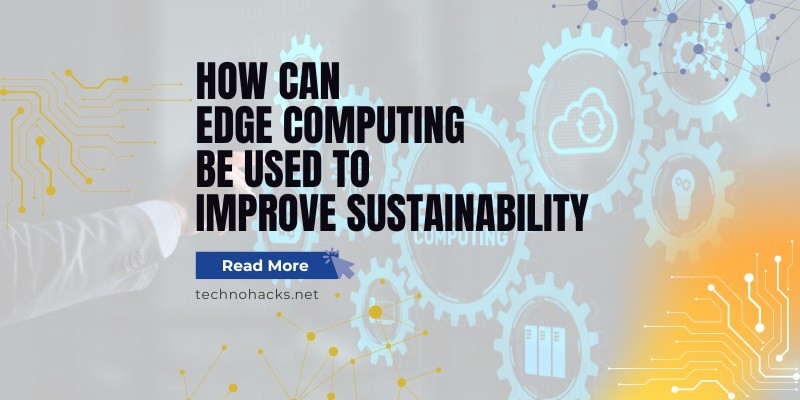Last Updated on May 5, 2025 by Jim C.
As the world grapples with environmental challenges, innovative technologies are emerging as powerful tools for promoting sustainability. Edge computing, a distributed computing paradigm that brings data processing closer to the source, stands out as a promising solution for reducing energy consumption, optimizing resource utilization, and enabling more sustainable practices across various industries.
Edge Computing and Its Sustainability Potential
Edge computing is a decentralized approach to data processing that moves computation and storage closer to the devices generating data, rather than relying solely on centralized cloud data centers. This paradigm shift offers several sustainability benefits:
- Reduced Energy Consumption: By processing data locally, edge computing minimizes the need for data transmission to distant data centers, significantly reducing energy consumption associated with network infrastructure.
- Lower Carbon Emissions: The reduction in data transmission directly translates to lower carbon emissions from network operations and data centers.
- Improved Resource Utilization: Edge computing enables more efficient use of existing hardware and infrastructure, reducing the need for new equipment and minimizing electronic waste.
Applications of Edge Computing for Sustainability
Smart Cities
Edge computing plays a crucial role in developing sustainable smart cities:
- Traffic Management: Real-time data processing at the edge enables intelligent transportation systems to optimize traffic flow, reducing congestion and lowering emissions.
- Smart Lighting: Edge-powered smart lighting systems can adjust illumination based on real-time conditions, significantly reducing energy waste.
Agriculture
In the agricultural sector, edge computing contributes to sustainable farming practices:
- Precision Farming: Edge devices enable real-time monitoring of soil conditions, weather, and crop health, allowing farmers to optimize water usage, fertilizer application, and pesticide use.
- Smart Irrigation: Edge-powered irrigation systems can analyze local conditions to deliver precise amounts of water, conserving this vital resource.
Industrial and Manufacturing
Edge computing is transforming industrial processes to be more sustainable:
- Real-Time Monitoring: Edge devices enable continuous monitoring of manufacturing processes, allowing for immediate adjustments to reduce energy consumption and minimize waste.
- Predictive Maintenance: By processing data locally, edge computing facilitates predictive maintenance, reducing downtime and improving overall operational efficiency.
Environmental Monitoring and Protection
Edge computing enhances our ability to monitor and protect the environment:
- Air and Water Quality Monitoring: Distributed edge devices can continuously monitor air and water quality, providing real-time data for rapid response to environmental threats.
- Wildlife Conservation: Edge computing enables real-time tracking and monitoring of wildlife, supporting conservation efforts in remote areas.
Overcoming Challenges for Sustainable Edge Computing
While edge computing offers significant sustainability benefits, several challenges need to be addressed:
- Energy Efficiency of Edge Devices: As the number of edge devices grows, ensuring their energy efficiency becomes crucial. Research is ongoing to develop more energy-efficient hardware and software solutions for edge computing.
- Security and Privacy: The distributed nature of edge computing introduces new security challenges. Implementing robust encryption, authentication protocols, and secure communication channels is essential to protect sensitive data.
- Scalability and Resource Constraints: Edge devices often have limited processing power and storage capacity. Implementing edge orchestration frameworks and leveraging fog computing can help overcome these limitations.
- Network Connectivity and Reliability: Ensuring reliable connectivity for edge devices, especially in remote areas, remains a challenge. Technologies like 5G and satellite internet are being explored to address this issue.
- Data Management: Efficiently managing and storing the vast amounts of data generated at the edge is crucial. Implementing data aggregation, compression, and intelligent filtering techniques can help optimize data management.
Best Practices for Sustainable Edge Computing
To maximize the sustainability benefits of edge computing, organizations should consider the following best practices:
- Optimize Energy Consumption: Implement power management techniques and use renewable energy sources where possible for edge devices.
- Prioritize Data Processing: Analyze and filter data at the edge to reduce unnecessary data transmission and storage.
- Implement Circular Economy Principles: Design edge devices for longevity, repairability, and recyclability to minimize electronic waste.
- Leverage AI and Machine Learning: Utilize AI algorithms at the edge to optimize resource usage and improve overall system efficiency.
- Collaborate Across Industries: Foster partnerships between technology providers, sustainability experts, and industry leaders to develop innovative edge computing solutions for sustainability.
Future Prospects
As edge computing technology continues to evolve, its potential for improving sustainability is expected to grow. Emerging trends include:
- Green Edge Data Centers: Development of highly efficient, small-scale data centers powered by renewable energy sources.
- Edge AI for Sustainability: Advanced AI algorithms run on edge devices to further optimize resource usage and enable more sophisticated sustainability applications.
- Integration with 5G and IoT: The combination of edge computing with 5G networks and IoT devices will enable more comprehensive and efficient sustainability solutions across various sectors.
Conclusion
Edge computing presents a significant opportunity to drive sustainability efforts across multiple industries. By bringing computation closer to the data source, it enables more efficient resource utilization, reduced energy consumption, and real-time decision-making for environmental protection. As the technology matures and challenges are addressed, edge computing is poised to play an increasingly crucial role in building a more sustainable future.

